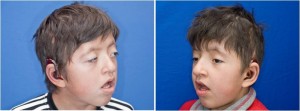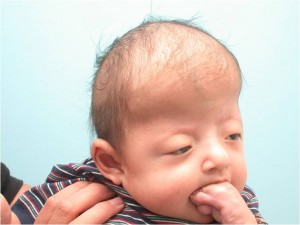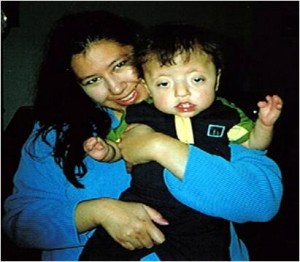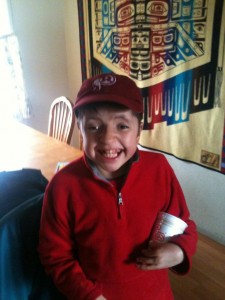The new technique was recently published in the journal of Plastic and Reconstructive Surgery, “Normalizing Facial Ratios in Apert Syndrome Patients with Lefort II Midface Distraction and Simultaneous Zygomatic Repositioning.”
Apert syndrome is a rare condition that occurs in one of 45,000 to 160,000 live births. For the children it affects, it’s very complex and is not only challenging to live with, but it’s also very difficult to treat.
That is, until now.
 Thanks to Richard Hopper, MD, surgical director of the Craniofacial Center at Seattle Children’s Hospital, there is now a new treatment method that offers kids with Apert syndrome the opportunity to have a much better quality of life.
Thanks to Richard Hopper, MD, surgical director of the Craniofacial Center at Seattle Children’s Hospital, there is now a new treatment method that offers kids with Apert syndrome the opportunity to have a much better quality of life.
The new surgical approach not only treats symptoms more effectively, but also treats the “look” of the syndrome, offering children the chance to have a more normal face and head shape.
Apert syndrome
Before diving into the details of the new treatment, it’s important to understand Apert syndrome. Apert syndrome is a genetic disorder caused by the premature fusion of the sutures in the skull bones, which prevents the skull from growing normally. This affects the shape of the head and increases pressure on the growing brain.
Babies born with Apert syndrome often have faces with a concave, spoon-like shape, bulging eyes and a smaller, beaked nose. The fusion of the skull also leads to an underdeveloped upper jaw and crowded teeth, causing dental problems. Fingers and toes are often fused together, or webbed, and children can experience hearing loss, developmental delays and sleep apnea.
Hopper says that the biggest concern is the sleep apnea. He said children must feel like they have a tennis ball in their throat because the facial bones are blocking the airway. If left untreated, it can greatly impact a child’s life, affecting brain development and energy levels, and can in time strain the heart.
The stigma
The difficulties of Apert syndrome go beyond the physical challenges. Hopper says that the stigma around Apert syndrome can greatly affect a child’s social interactions and ability to make friends.
“As humans we instinctively scan a person’s face when we meet them, and if the proportions and balance of the face look right, then we will be more likely to interact,” said Hopper. “In a person with Apert syndrome, the bones of their face are in a compressed jigsaw puzzle. For someone meeting them for the first time, it can be hard for the person to get past why their face looks wrong, preventing them from being able to properly interact and accept the person with the syndrome.”
Hopper says that this can be very difficult for kids, especially as they go through school, grow up and try to find a place where they feel like they belong.
The traditional treatment for Apert syndrome, LeFort III midface advancement, brings several bones in the midface forward the same distance and in one direction. While it’s effective in helping patients breathe better, it does not normalize the proportions and look of the face.
Hopper, who performs some of the highest annual numbers of these surgeries in the country, became frustrated that the traditional treatment was not able to address the whole syndrome. It especially hit home when one patient told Hopper, “Thanks for helping me breathe better, but you didn’t get rid of my syndrome.”
Hopper was determined to find a better way.
A better way to treat Apert syndrome: Segmental subcranial distraction
Over the course of five years, Hopper developed the new, novel technique of Segmental subcranial distraction, which allows him to create more normal facial proportions.
“Before, we just moved all the facial bones together as one block,” said Hopper. “But we have found that you have to move different parts of the face in different directions and at different degrees in order to correct the face to a more normal position. Part of the face needs to move down and part of it needs to move up. Essentially, you have to unlock the compressed jigsaw puzzle and then reassemble it.”
Here’s how it works:
- During the delicate surgery, the bones of the face are separated from the skull so that the entire face is mobile. The cheekbones and eye sockets are then released from the middle of the face and repositioned into a more normal position. The forehead is smoothed and advanced with a custom implant designed specifically for the child.
- A device called a distractor, also known as a halo, is then attached to the central part of the face that is still mobile.
- For the next two to three weeks, while the child is at home, a parent or caregiver turns the distractor 1 to 2 millimeters a day to continually move the bones. This can move the upper jaw up to an inch or more. New bone then grows to fill in the gaps and the distractor stays on for about six more weeks to allow for healing. Once everything is in the right position, the distractor is removed.
The result
Once treatment is complete, a child’s breathing passage is opened and the child has more normal facial proportions. Their cheekbones and forehead are moved forward the necessary amount. Their nose, upper jaw and teeth are moved a greater distance forward and down, eliminating the concaved shape and allowing the teeth to fit together. Children also have a less compressed look and their eye sockets become more rounded.
To date, Children’s has treated five patients with this approach with excellent results.
“After the treatment, it’s often the first time I see a patient with Apert Syndrome break out into a big smile because they can see the change,” said Hopper. “I’m excited we can now offer something we couldn’t offer before and seeing the smile on their face is a wonderful feeling. That’s why the team is here and we do what we do.”
Hopper says that the surgery also has a profound impact on kids’ confidence, self-esteem and social interactions because they are no longer stigmatized by the way they look.
“It makes it easier for a child to interact with their peers, meet new friends and grow as adults,” said Hopper. “We have had very positive feedback from patients where they say that for the first time in their life, people say that they look great and they have never heard that before.”
A personal perspective: James’ journey
Ten-year-old James Weatherwax was the fifth patient in the U.S. to receive Hopper’s new surgical treatment.

When James was born, the seams in his skull were fused together, leaving his brain little room to grow, and his face, hands and feet were misshapen. He also had a cleft lip and palate and suffered from seizures.
His mom, Kecia Weatherwax, was completely shocked.
“There was no indication that anything was wrong but it just happened,” said Kecia. “My mind was racing when he was born because I didn’t know what it was and how it could happen to my baby.”
Kecia took James to a Native clinic in Alaska and since they weren’t familiar with the condition or how to treat it, they turned them away. Frustrated, Kecia took James to another clinic in Ketchikan, Alaska, and they referred her to Seattle Children’s where she found answers.
 From there on, going to the doctor became a natural fabric of James’ life. He has had about 15 surgeries on his skull, face, hands and feet.
From there on, going to the doctor became a natural fabric of James’ life. He has had about 15 surgeries on his skull, face, hands and feet.
As James grew, Kecia worried about how he’d be accepted by others. She was lucky to find a community, Klawock, Alaska, where people know her son and really accept him. But this wasn’t always the case in other cities that they’d visit.
“There were times where kids have been cruel and people can just be really mean because they don’t understand him,” said Kecia.
When Kecia found out about the new treatment option, she was hesitant. But she decided to move ahead with it because she wanted to improve James’ chances of having a normal life.
“We love him whatever he looks like, but I had to do this to improve his quality of life,” said Kecia.
 In February, James underwent the surgery and in March his distractor device was removed.
In February, James underwent the surgery and in March his distractor device was removed.
The result can be seen in the big smile James had on his face when the device was removed and in how he is doing today.
“He is doing really well and is just being a happy boy who is always on the go,” said Kecia. “He goes out to play with his friends and he loves playing basketball and swimming. He has a lot more freedom, is much more active and is a lot more independent. He is capable of doing anything.”
Hopper is also happy with James’ outcome.
“He looks great and for the first time, James can sleep without snoring because he is able to breathe well,” said Hopper. “My hope for James is that he will be a happy healthy young man and I am excited to see him grow into that. Now he has the big surgeries behind him and he can just enjoy life.”
To learn more about James’ story, please visit this Los Angeles Times article and video about his journey. You can also learn more about the treatment by visiting the Los Angeles Times story, “With new plastic surgery technique, boy’s face is removed, realigned.”
Sharing the knowledge
Hopper will present the new technique to colleagues from around the world later this year at an international forum so other doctors can offer this technique to their patients.
“It’s been a joy to be able to offer kids this new technique that has such a good outcome,” said Hopper. “There aren’t a lot of other centers that are able to focus on revolutionizing the way we treat Apert syndrome and we look forward to sharing the knowledge and offering it to other kids in the future.”
For more information about the new surgical procedure or to arrange interviews with Dr. Hopper or Kecia, please contact the public relations team at 206-987-4500 or [email protected].

